The device of a septic tank: the principle of operation and basic organization schemes
Country houses and summer cottages, as a rule, are remotely located from the centralized sewer network. Therefore, the issue of organizing a local treatment system for many homeowners is very relevant. The best solution is to install a septic tank in the area.
However, it is difficult for an uninformed consumer to navigate the variety of offers. But, you see, it is precisely from a competent choice that the uninterrupted operation of equipment and the sewage system as a whole depends in many respects.
To facilitate your task, we have prepared a detailed overview of autonomous structures. We will understand what the septic tank structure is and the general principle of the purification system. And also denote the features of the functioning, installation and operation of different septic tanks.
Based on the information given, photo and video selections, you can determine the optimal modification of the unit for your own needs.
The content of the article:
The main elements of a septic tank
Septic is a local sewage treatment plant designed to equip a sewerage system independent of central networks.
The main tasks of the element are the temporary accumulation of effluents and their subsequent filtration. Modern septic tanks have become an improved alternative to traditional cesspools.
Understanding the device and the mechanism of operation of the septic tank will facilitate the selection of a treatment plant and its installation.
Designs of various modifications have some common components. The treatment system is a sealed tank, including one or more compartments.
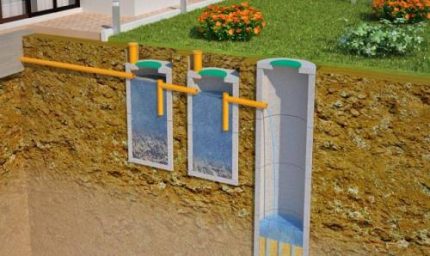
The septic tank is divided by partitions. The movement of fluid between them is carried out by overflow pipes.
A drain pipe is brought to the first compartment from the internal sewage of the house, and purified water is discharged from the last chamber to the ground or semi-purified to soil post-treatment.
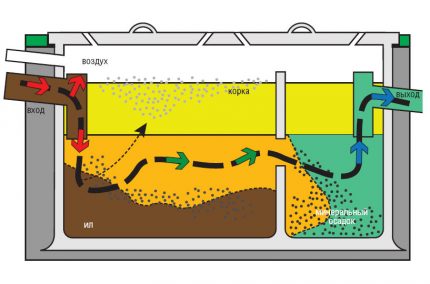
The main components of all treatment plants are:
- Tanks for sedimentation. Storage tanks are made of plastic, metal, concrete or brick. The most preferable models are made of fiberglass and polypropylene - the materials are resistant to abrasion and guarantee the tightness of the tank throughout the entire life cycle.
- Incoming and outgoing piping. Overflow nozzles are installed at a slope, providing unhindered flow of fluid between the tanks.
- Elements of service. Revision wells and hatches. At least one well is installed on the outer route of the sewer pipeline. With an increase in the length of the branch of more than 25 m, an additional audit is arranged.
- Ventilation system. Regardless of which bacteria (anaerobic or aerobic) are involved in the processing of wastewater, air exchange is necessary for the normal functioning of microorganisms, removal of methane and maintaining the desired temperature.
The simplest scheme for ventilation of a local sewage system includes one riser at the beginning of the system, and the second at the extreme section of the septic tank. When arranging filtration fields, a ventilation riser is installed on each drain pipe.
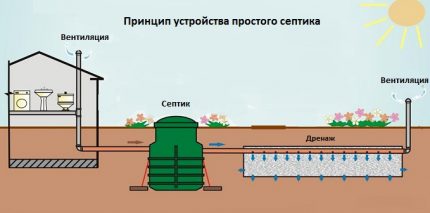
General principle of operation of the treatment plant
The functioning of any septic tank is based on the principles of gravity sedimentation and biological filtration using a natural or forced method. Perhaps the use of bioenzyme preparations and biofilters. Conventionally, the sewage treatment sequence can be divided into several standard stages.
Stage 1. Primary cleaning. Wastewater flows into the first tank or compartment through the sewer pipe from the house. Here is a rough cleaning of suspended large particles. Heavy suspensions (grains of sand and similar insoluble inclusions of drains) settle to the bottom of the chamber. Light fractions (fats and oils) rise to the surface and flow into the next compartment.
Stage 2. Heavy particle decomposition. The waste that sinks to the bottom of the first chamber begins to ferment and decompose - the process takes about 3 days. As a result, sewage disintegrates into a thick mass, carbon dioxide and water.
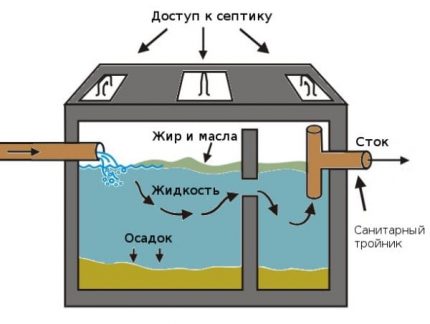
Stage 3. Re-cleaning. In the second chamber, re-decomposition of sewage occurs. In some septic tanks, at this stage, due to the action of special bacteria and preparations, chemical (personal hygiene waste) and organic compounds decompose.
Stage 4. Liquid outletand. The further way of water depends on the type of treatment system. The purified liquid may enter the tank for subsequent irrigation of the garden.
If the degree of purification is insufficient, then the water undergoes a post-treatment process through the infiltrate, drainage well, fields for soil filtration, etc.
A schematic description of the traditional principle of operation of a septic tank conveys the general features of the process. Each modification of the treatment plant has structural and operational nuances of execution.
Features of the work of different types of septic tank
All local treatment systems are divided into three categories: storage tanks, sedimentation models with soil post-treatment and septic tanks for deep biological sewage treatment. Consider how each of the septic tanks works in more detail.
Accumulative sewage system
In fact, the storage septic tank is an analog cesspool - sealed durable single-chamber tank into which sewage enters. In storage-type constructions, waste is collected and temporarily stored. As the tank is filled, the effluent is pumped out using wastewater.
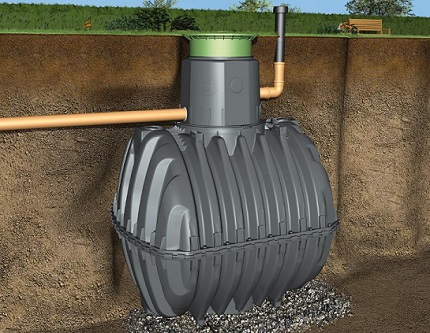
The scheme of the sewer system is as simple as possible and consists of a drive and an external pipeline.
Septic can be additionally equipped with:
- check valve - prevents the movement of sewage in the opposite direction;
- alarm with drain level sensor - notifies the owners about the filling of the tank and the need for pumping sewage.
Popular models of storage septic tanks: Bars-N, bug, Rodlex Purges.
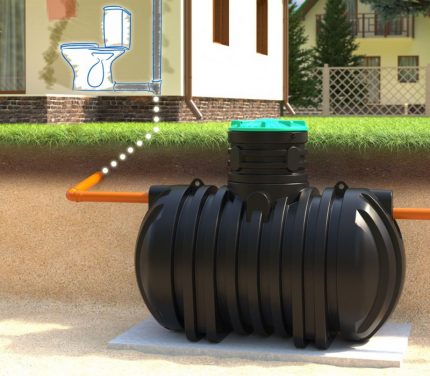
Sumps with soil treatment systems
Units with soil post-treatment are referred to the overflow category of structures. The system consists of two or three sections and a device for additional filtration of wastewater. Once in the storage tank, the waste mass settles and decomposes under the influence of anaerobic bacteria.
Flowing from tank to tank, the waste mass goes through several stages of natural separation. However, the degree of purely mechanical processing reaches a maximum of 65 - 70%. Therefore, for proper treatment, effluents leaving the sumps must undergo additional post-treatment before disposal and discharge onto the terrain or into the ground.
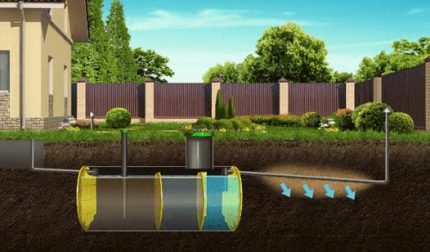
Ways of organizing soil wastewater treatment:
- filtration well;
- underground cleaning field;
- filtering trench.
Filter well. It is installed in sandy soils of various sizes and densities. It is possible to use in sandy loam with a minimum number of ductility.
To make filter well It is possible from prefabricated reinforced concrete elements, stone or brick. The structure does not have a bottom - the base of the well is covered with gravel. The height of the drainage layer is 1 m.

Underground filtering field. A complex of perforated pipes located on a filtering site - sand and gravel backfill. The water clarified and settled in the septic tank is supplied to the irrigation pipes with holes.
Liquid seeps and enters the soil filter. Pipes can be connected by a collector jumper to the ventilation outlet or be equipped with separate ventilation risers.
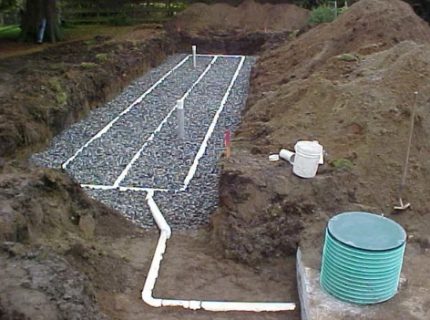
Filter Trench System. The facility is used on clay soils and in areas with the possibility of discharging treated effluents into an unused reservoir. In the prepared trenches with a depth of 1.5-1.7 m, they are placed in two tiers of pipe: the upper one is called irrigation, the lower drain.
The sedimented water in the septic tank enters the upper pipeline, seeps through the perforation and passes after-treatment through crushed stone and sand. Then, the wastewater passing through the natural soil filter is collected by the underlying drainage pipe - draene, through which it is discharged to the disposal site.

The main "element" of the wastewater treatment and disposal is not the drainage structure, but the directly multilayer soil filter. It is only necessary to assemble an interface for the effective distribution of fluid in the earth.
Septic tank with biological treatment
Bioseptic - a deep cleaning station based on microorganisms. The system is a sealed single unit, reinforced with stiffeners and divided into several chambers. The number of sections determines the cleaning efficiency.
Drains falling into the septic tank through a sewer pipe are subjected to different cleaning methods.The outlet water is purified by 90 - 96% or more, which allows it to be used for watering plants or drained into a pond. Additional filtration in soil systems is not required.

The order of the "bioseptic":
- The first chamber acts as a sump. Here, sewage is divided into particles of heavy and light fractions, forming a floating film and sediment, and is processed by anaerobes that do not need oxygen supply.
- In the second compartment, organic matter and inorganic waste decompose under the influence of aerobic microorganisms, which require regular oxygen supply for processing and their own life.
- In the third chamber, the filtered effluents are disinfected with chemical components or re-exposed to aerobic bacteria.
To activate aerobic microorganisms, oxygen must enter the septic tank - the device is equipped with an aerator. Therefore, most bioremediation plants are volatile.
The basic schemes of popular models
In an effort to increase the effectiveness of the septic system, manufacturers are constantly improving the design of units. Some try to lighten the design and make the operation scheme more understandable, while others increase the number of cycles and the quality of cleaning by introducing innovative technologies.
Tank - comprehensive cleaning with infiltrator
Septic tank Tank - treatment system with soil purification devices. The solid body of the device is reinforced with thick stiffening ribs 17 mm thick. Due to its design, the septic tank can be installed on different soils.
Thanks to the block-modular structure, if necessary, it is possible to “increase” the system performance.

The cycle of water purification in a septic tank is divided into the following stages:
- Heavy inorganic substances are deposited in the receiver. The clarified water flows into the second compartment.
- The fluid undergoes anaerobic digestion and breaks down into simple compounds during fermentation. In the second chamber are membranes that retain fatty fractions.
- In two-compartment sumps, the cleaning cycle ends in the infiltrator. In three-chamber tanks, water undergoes biological treatment. The last compartment is filled with a colony of bacteria capable of utilizing impurities.
At the outlet, the water is purified by 75-80% (depending on the number of chambers). For complete clarification, the system is supplemented by an infiltrator - a tank without a bottom, installed in a trench on a “pillow” of sand and gravel.
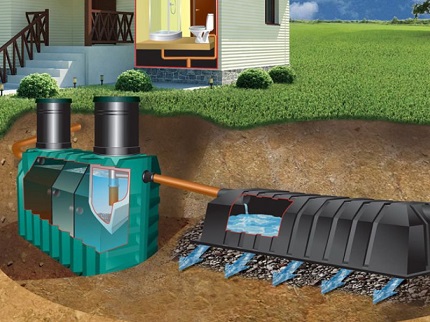
Topas - multistage biofiltration
Septic tank Topas - sewage system of deep biological treatment. The device unit is fundamentally different from the design of "horizontal" septic tanks. The vertically oriented housing is divided into 4 sections, circulating between which, sewage is cleaned by 98%.
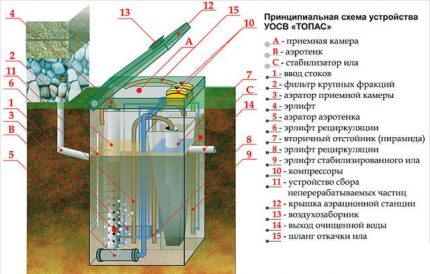
On the aerobic septic tank device diagram it is seen that all sections of the treatment plant are interconnected by hoses. Airlift is a type of pipe pump that transports purified water, sludge and other impurities from one compartment to another.
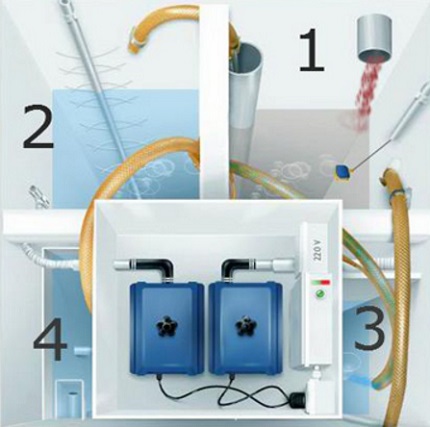
Compartment 1. Primary sewage enters the chamber and, under the influence of aerobic bacteria, breaks down into light components, water and sludge.
Compartment 2. Drains purified by 45-50% get into the chamber. In aeration tanks, airflow raises small particles to the surface of the water. The compartment has a pyramidal shape, which contributes to the rapid deposition of sludge. Through airlift, fluid flows into the next chamber.
Compartment 3. In the secondary sump, sewage is re-converted to water and sludge.
Compartment 4. Purified water accumulates in the chamber. As the tank is full, a liquid level sensor rises, transmitting a signal to the drain pump to fill the tank.
Triton - non-volatile cleaning system
Septic tanks Triton performs mechanical and biological filtration with soil post-treatment. Important advantages of Triton models: compactness and simplicity of design. For a summer cottage, a small country estate or an allotment with a bathhouse, the Triton Mini septic tank is often chosen.
Two tanks are interconnected in the upper pipes and at the bottom. This solution increased the space for accumulation of sludge on a common bottom, and semi-purified water allowed to flow freely into the adjacent compartment.
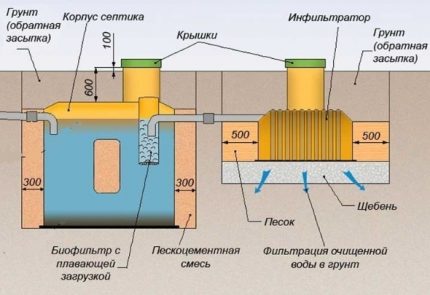
For post-treatment of wastewater in a local treatment system Triton Mini infiltration is provided Triton 400.
Ecopan - six-stage sewage filtration
Septic tank Ecopan - Local station with a full cycle of biological treatment of sewage. The design is designed for difficult operating conditions: heaving, clay soil, a high level of groundwater, a large depth of laying the supply pipe.
Cylindrical tank with reinforced bottom. The rigidity of the tank is increased by transverse partitions. Inside the septic tank is divided into six chambers.

Operating principle:
- In the septic chamber, the waste mass settles and solid fractions settle.
- In the anaerobic compartment, microorganisms process waste water, purifying and clarifying them.
- In aerotank aerobic bacteria come into action. The aerator saturates the sewage with oxygen, activating the action of microorganisms and accelerating the decay of organic, inorganic substances.
- The secondary sump accumulates sludge residues, which are pumped into the first chamber with airlift for re-treatment.
- The post-treatment bioreactor contains dolomite. Mineral promotes better filtration of effluents.
- In the third sedimentation tank, there is also an airlift that displays sediment in the first chamber.
After treatment, the purified water is discharged into natural soil or discharged into a storage tank for technical use.
Rodlex - a septic tank of accumulative type
Storage tank Rodlex made of polymer by rotational molding. The solid cast capacity is equipped with elongated necks and covers (hatch diameter - 80 cm). Septic tank is used as a cesspool.
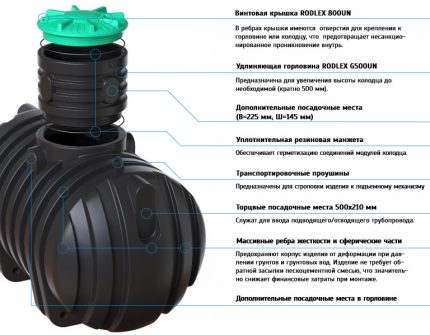
If it is necessary to expand the working volume, several tanks are connected in series to each other in a single storage system.
Fast - aerobic disposal technology
Septic tank Fast - An innovative solution for the treatment of domestic wastewater. The unit is designed in such a way that the waste mass processing is carried out as quickly as possible.
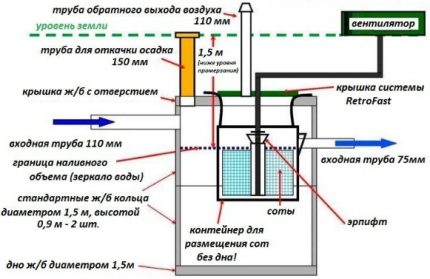
Sewage entering the receiving compartment is immediately treated with aerobic microorganisms. With the help of a compressor and a fan, air is fed into the septic tank - biomass is activated and breaks down the waste. In the cellular structure of the sewage module, air and active microorganisms mix - the effluents are converted to water and sediment.
At the same time, an airlift is included in the operation, which ensures the movement of fluid in the second compartment. Here, water settles and clarifies naturally - silt falls to the bottom. Anaerobic bacteria continue to work on the decomposition of sewage.
The clarified liquid is discharged through the outlet. In parallel with the discharge, a new portion of sewage is taken.
Septic Fast - a self-regulating system that adapts to wastewater with large fractions or sewage with chemical components. Due to the cellular structure of the module, bacteria are capable of self-healing.
The action of aggressive chemicals kills microorganisms deposited on the walls of the septic tank and the surface of the effluent. Bacteria inside the cells survive and continue to multiply actively.
Conclusions and useful video on the topic
A complete picture of the device and the principle of operation of treatment plants will help to make visual videos.
The main components of the local sewerage system based on the septic tank and the principle of its action:
The principle of fluid movement in autonomous sewage Topas:
The order of deep wastewater treatment on the example of the septic tank Unilos Astra:
Understanding the device and the principle of organizing the cleaning process, it will turn out to choose the most optimal model of a septic tank. Despite the external similarity, each modification has its own technical and operational features that must be considered when installing and maintaining the system.
Are you looking for a septic tank for a country house or cottage? Or have experience using such installations? Please leave comments on the article and share your impressions about the use of autonomous treatment facilities.

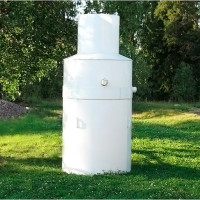 Overview of the cedar septic tank: device, principle of operation, advantages and disadvantages
Overview of the cedar septic tank: device, principle of operation, advantages and disadvantages 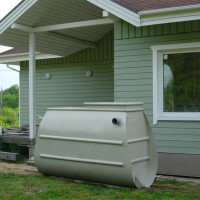 Overview of the Tver septic tank: device, principle of operation, advantages and disadvantages
Overview of the Tver septic tank: device, principle of operation, advantages and disadvantages 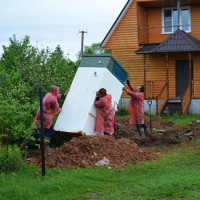 Overview of the Eco-Grand septic tank: device, principle of operation, advantages and disadvantages of the system
Overview of the Eco-Grand septic tank: device, principle of operation, advantages and disadvantages of the system  Overview of the septic tank “Flotenk”: characteristics, operating principle, installation + analysis of modifications
Overview of the septic tank “Flotenk”: characteristics, operating principle, installation + analysis of modifications 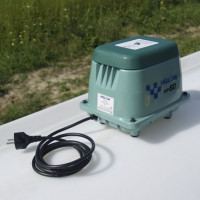 Compressor for septic tank: principle of operation, how to choose + operating rules
Compressor for septic tank: principle of operation, how to choose + operating rules 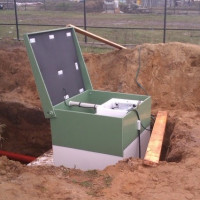 Overview septic tank for giving “Topas”: principle of operation, device, advantages and disadvantages
Overview septic tank for giving “Topas”: principle of operation, device, advantages and disadvantages  How much does it cost to connect gas to a private house: the price of organizing gas supply
How much does it cost to connect gas to a private house: the price of organizing gas supply  The best washing machines with dryer: model rating and customer tips
The best washing machines with dryer: model rating and customer tips  What is the color temperature of light and the nuances of choosing the temperature of the lamps to suit your needs
What is the color temperature of light and the nuances of choosing the temperature of the lamps to suit your needs  Replacement of a geyser in an apartment: replacement paperwork + basic norms and requirements
Replacement of a geyser in an apartment: replacement paperwork + basic norms and requirements
Oh, that's the system. I'm going to put myself a septic tank in the summer, so I'm looking for various kinds of info. In principle, the device is understandable, I wonder how much it will all cost, and where to order the installation. I figured it, Topas is more suitable for me, because the site is small and the vertical unit is the most reasonable option. There would be a bigger picture with its device, otherwise I can’t make out where and why.
Email me chinateampro2015@gmail.com. I once designed them as part of various cleaning systems and carried out commissioning. I will explain to you all the nuances of the installation.
Hello. Perhaps this will be better seen.
Here you need to decide: either you need to build a cesspool, or do the septic tank device. If you have a shower or bath, toilet and washing machine, in my opinion, it is easier to make a septic tank. There are no particular difficulties in this.First of all, this is a tank consisting of several compartments or several cameras in series. Compartments / chambers are connected by nozzles, through which water is poured from one compartment to another. From the sewage system from the house, the pipe comes to the first compartment, the treated effluents go into the filtration field or into a drive for watering the soil. Now popular plastic tanks are durable and affordable.
We have a high groundwater level on the site. Choose between the old Tver and modern Evrolos GRUNT. As a result, we ordered the second one, because it is essentially the same Tver, only finalized and brought to mind. We are very pleased with the septic tank. According to the manufacturer, the degree of purification is 99%, so far there are not even competitors!
My opinion is the degree of purification, striving for 100% - this is nothing more than an advertising gimmick. There is no such thing.